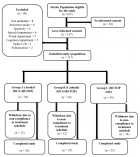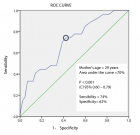Abstract
Research Article
Efficacy of transcranial direct current stimulation and over-ground walking task on functional mobility and quality of life of stroke survivors
Caleb A Adeagbo*, Caleb AO Gbiri and Olajide A Olawale
Published: 03 December, 2020 | Volume 4 - Issue 2 | Pages: 049-056
Introduction: High proportion of stroke survivors have impaired functional mobility and decrease in overall quality of life (QoL). Transcranial direct current stimulation (tDCS) (non-invasive brain stimulation) and over-ground walking task (OGWT) (functional task-oriented training) have been suggested to improve functional mobility and QoL of stroke survivors. Hence, this study determined the efficacy of tDCS (anodal and cathodal) with OGWT on functional mobility and QoL of stroke survivors.
Materials and methods: Seventy eight (78) stroke survivors were randomised into three groups: anodal group (anodal tDCS with OGWT); cathodal group (cathodal tDCS with OGWT) and control group (OGWT only). Participants had two sessions of intervention per week for six weeks. Functional mobility was assessed using 10 meter walk test (10MWT) measuring steps, time and velocity while QoL was measured using Stroke Specific QoL (SSQoL) scale. Significance level was set at p < 0.05.
Results: Participants (46 males) were aged 56.78 ± 10.24 years. The groups were matched for functional mobility and QoL at baseline and only work/productivity domain of SSQoL showed statistically significant difference (p = 0.028). Each group showed statistically significant improvement between baseline and post-intervention scores of items in functional mobility (p ≤ 0.001) and total SSQoL (p ≤ 0.001). Anodal group showed better statistically significant improvement in step (p = 0.008), time (p = 0.024), velocity (p = 0.001) and total SSQoL (p = 0.016) among the groups when the mean differences were compared.
Conclusion: tDCS with OGWT is efficacious in improving functional mobility and QoL of stroke survivors. Specifically anodal tDCS with OGWT showed better clinical improvement in step, time, velocity and QoL in stroke survivors.
Read Full Article HTML DOI: 10.29328/journal.jnpr.1001037 Cite this Article Read Full Article PDF
Keywords:
Transcranial direct current stimulation; Over-ground walking; Lower limb; Quality of life; Stroke survivors
References
- Chen C, Tsai C, Chung C, Chen C, Wu KPH, et al. Potential predictors for health-related quality of life in stroke patients undergoing inpatient rehabilitation. Health Qual Life Out. 2015; 13: 1-10.
- De Wit L, Theuns P, Dejaeger E, Devos S, Gantenbein AR, et al. Long-term impact of stroke on patients’ health-related quality of life. Disabil. Rehabil. 2017; 39: 1435-1440 PubMed: https://pubmed.ncbi.nlm.nih.gov/27385479/
- Walsh ME, Galvin R, Loughnane C, Macey C, Horgan NF. Community re-integration and long-term need in the first five years after stroke: results from a national survey. Disabil Rehabil. 2015; 37: 1834-1838. PubMed: https://pubmed.ncbi.nlm.nih.gov/25391817/
- Badaru UM, Ogwumike OO, Adeniyi AF. Health related quality of life of stroke survivors in Africa: a critical review of literature. Arch Physiother Glob Res. 2015; 19: 7-16.
- Alghwiri AA. The Correlation between Depression, Balance and Physical Functioning Post Stroke. J Stroke Cerebrovasc. 2016; 25: 475-479. PubMed: https://pubmed.ncbi.nlm.nih.gov/26617326/
- Mehrholz J, Pohl M, Kugler J, Elsner B. The Improvement of Walking Ability Following Stroke a Systematic Review and Network Meta-Analysis of Randomized Controlled Trials. Dtsch Arztebl Int. 2018; 115: 639–645. PubMed: https://pubmed.ncbi.nlm.nih.gov/30375325/
- An T, Kim S, Kim K. Effect of transcranial direct current stimulation of stroke patients on depression and quality of life. J Phys Ther Sci. 2017; 29: 505-507. PubMed: https://pubmed.ncbi.nlm.nih.gov/28356641/
- Gbiri CA, Akinpelu AO. Quality of life of Nigerian stroke survivors during first 12 months post-stroke. Hong Kong Physiother J. 2012; 30: 18-24.
- Mortensen J, Figlewski K, Andersen H. Combined transcranial direct current stimulation and home-based occupational therapy for upper limb motor impairment following intracerebral hemorrhage: a double-blind randomized controlled trial. Disabil Rehabil. 2016; 38: 637-643. PubMed: https://pubmed.ncbi.nlm.nih.gov/26079636/
- Rocha S, Silva E, Foerster A, Wiesiolek C, Chagas AP, et al. The impact of transcranial direct current stimulation (tDCS) combined with modified constraint induced movement therapy (mCIMT) on upper limb function in chronic stroke: a double blind randomized controlled trial. Disabil. Rehabil. 2016; 38: 653-660. PubMed: https://pubmed.ncbi.nlm.nih.gov/26061222/
- Eryilmaz G, Sayar GH, Ünsalver BO, Gül IG, Özten E, et al. Adverse Effects of Transcranial Direct Current Stimulation (TDCS) in a Group of Psychiatric Patients. SJAMS. 2014; 2: 294-297.
- Kuo M, Paulus W, Nitsche MA. Therapeutic effects of non-invasive brain stimulation with direct currents (tDCS) in neuropsychiatric diseases. NeuroImage. 2014; 85: 948-960. PubMed: https://pubmed.ncbi.nlm.nih.gov/23747962/
- Fusco A, De Angelis D, Morone G, Maglione L, Paolucci T, et al. The ABC of tDCS: Effects of Anodal, Bilateral and Cathodal Montages of Transcranial Direct Current Stimulation in Patients with Stroke - A Pilot Study. Stroke Res Treat. 2013; 2013: 837595. PubMed: https://pubmed.ncbi.nlm.nih.gov/23365790/
- Fleming MK, Rothwell JC, Sztriha L, Teo JT, Newhama DJ. The effect of transcranial direct current stimulation on motor sequence learning and upper limb function after stroke. Clin Neurophysiol. 2017; 128: 1389-1398. PubMed: https://pubmed.ncbi.nlm.nih.gov/28410884/
- Claflin ES, Krishnan C, Khot SP. Emerging treatments for motor rehabilitation after stroke. The Neurohospitalist. 2015; 5: 77-88. PubMed: https://pubmed.ncbi.nlm.nih.gov/25829989/
- Pollock A, Baer G, Campbell P, Choo PL, Forster A, et al. Physical rehabilitation approaches for the recovery of function and mobility following stroke (Review). In: Cochrane database of systematic reviews (Fourth Edition). John Wiley & Sons Ltd. 2014; 1-433. PubMed: https://pubmed.ncbi.nlm.nih.gov/24756870/
- Olawale OA, Jaja SI, Anigbogu CN, Appiah-Kubi KO, Jones-Okai D. Exercise training improves walking function in an African group of stroke survivors: a randomized controlled trial. Clin Rehabil. 2011; 25: 442-450. PubMed: https://pubmed.ncbi.nlm.nih.gov/21427155/
- Badaru UM, Ja’afar M, Hassan Isa UL, Rufai YA. Comparative efficacy of treadmill training and combination of bicycle ergometer and over-ground walk on functional ambulation post-stroke - a pilot study. Fizjoterapia. 2019; 86-94.
- Bornheim S, Croisier J, Maquet P, et al. Brain Stimulation Transcranial direct current stimulation associated with physical- therapy in acute stroke patients - A randomized, triple blind, sham-controlled study. Brain Stimul. 2020; 13: 329-336. PubMed: https://pubmed.ncbi.nlm.nih.gov/31735645/
- van Asseldonk EHF. Transcranial Direct Current Stimulation Enhances Propulsion during Walking. W. Jensen et al. (eds.). Replace, Repair, Restore, Relieve – Bridging Clinical and Engineering Solutions in Neurorehabilitation, Biosystems & Biorobotics. 2014; 7: 805.
- Bai X, Guo Z, He L, Ren L, McClure MA, et al.Different Therapeutic Effects of Transcranial Direct Current Stimulation on Upper and Lower Limb Recovery of Stroke Patients with Motor Dysfunction: A Meta-Analysis. Neural Plast. 2019; 2019: 1372138. PubMed: https://pubmed.ncbi.nlm.nih.gov/31827495/
- Chhatbar PY, Ramakrishnan V, Kautz S, George MS, Adams RJ, et al. Transcranial Direct Current Stimulation post-stroke upper extremity motor recovery studies exhibit a dose-response relationship. Brain Stimul. 2016; 9: 16-26. PubMed: https://pubmed.ncbi.nlm.nih.gov/26433609/
- Geroin C, Picelli A, Munari D, Waldner A, Tomelleri C, et al. Combined transcranial direct current stimulation and robot-assisted gait training in patients with chronic stroke: a preliminary comparison. Clin Rehabil 2011; 25: 537-548. PubMed: https://pubmed.ncbi.nlm.nih.gov/21402651/
- Danzl MM, Chelette KC, Lee K, Lykins D, Sawaki L. Brain stimulation paired with novel locomotor training with robotic gait orthosis in chronic stroke: a feasibility study. NeuroRehabilitation 2013; 33: 67-76. PubMed: https://pubmed.ncbi.nlm.nih.gov/23949035/
- Manji A, Amimoto K, Matsuda T, Wada Y, Inaba A, et al. Effects of transcranial direct current stimulation over the supplementary motor area body weight-supported treadmill gait training in hemiparetic patients after stroke. Neuroscience Letter. 2017; 662: 302-305. PubMed: https://pubmed.ncbi.nlm.nih.gov/29107706/
- Fusco A, Assenza F, Iosa M, Altavilla R, Paolucci S, et al. The ineffective role of cathodal tDCS in enhancing the functional motor outcomes in early phase of stroke rehabilitation: an experimental trial. Biomed Res Int. 2014; 2014: 547290. PubMed: https://pubmed.ncbi.nlm.nih.gov/24895588/
- Peurala SH, Tarkka IM, Pitkanen K, Sivenius J. The effectiveness of body weight-supported gait training and floor walking in patients with chronic stroke. Arch Phys Med Rehabil. 2005; 86: 1557-1564. PubMed: https://pubmed.ncbi.nlm.nih.gov/16084808/
- Park HJ, Oh DW, Kim SY, Choi JD. Effectiveness of community-based ambulation training for walking function of post-stroke hemiparesis: a randomized controlled pilot trial. Clin Rehabil. 2011; 25: 451-459. PubMed: https://pubmed.ncbi.nlm.nih.gov/21245205/
- Kim M, Cho K, Lee W. Community walking training program improves walking function and social participation in chronic stroke patients. Tohoku J Exp Med. 2014; 234: 281-286. PubMed: https://pubmed.ncbi.nlm.nih.gov/25483170/
Figures:

Figure 1
Similar Articles
-
Postural Stability Induced by Supervised Physical Training may improve also Oxygen Cost of Exercise and Walking Capacity in Post-Menopause, Obese WomenFernanda Velluzzi,Massimiliano Pau,Andrea Loviselli,Raffaele Milia,Daniela Lai,Daniele Concu,Gianmarco Angius,Abdallah Raweh,Andrea Fois,Alberto Concu*. Postural Stability Induced by Supervised Physical Training may improve also Oxygen Cost of Exercise and Walking Capacity in Post-Menopause, Obese Women. . 2017 doi: 10.29328/journal.jnpr.1001001; 1: 001-011
-
How does a Personalized Rehabilitative Model influence the Functional Response of Different Ankle Foot Orthoses in a Cohort of Patients Affected by Neurological Gait Pattern?Maurizio Falso*, Eleonora Cattaneo,Elisa Foglia,Marco Zucchini,Franco Zucchini. How does a Personalized Rehabilitative Model influence the Functional Response of Different Ankle Foot Orthoses in a Cohort of Patients Affected by Neurological Gait Pattern?. . 2017 doi: 10.29328/journal.jnpr.1001010; 1: 072-092
-
Biomechanical analysis of Sit-To-Walk movement in Parkinson’s patientsMoataz M El Semary*,Nawal A Abou Shady,Hayam Mahmoud Sayed,Mohamed El Said Al Awaady. Biomechanical analysis of Sit-To-Walk movement in Parkinson’s patients. . 2018 doi: 10.29328/journal.jnpr.1001019; 2: 036-042
-
Perceptive and Rehabilitative Muscle Recruitment Facilitation Secondary to the use of a Dynamic and Asymmetric Spine Brace in the treatment of Adolescent Idiopathic Scoliosis (AIS)Maurizio Falso*, Laura Forti,Silvia Iezzi,Gloria Cottali,Eleonora Cattaneo,Marco Zucchini,Franco Zucchini. Perceptive and Rehabilitative Muscle Recruitment Facilitation Secondary to the use of a Dynamic and Asymmetric Spine Brace in the treatment of Adolescent Idiopathic Scoliosis (AIS). . 2018 doi: 10.29328/journal.jnpr.1001021; 2: 054-079
-
TRIA-MF protocol as an innovative tool in the comprehensive treatment and outcome evaluation of lower limb amputees before and after prosthesis useMaurizio Falso*,Silvia Zani,Eleonora Cattaneo,Marco Zucchini,Franco Zucchini. TRIA-MF protocol as an innovative tool in the comprehensive treatment and outcome evaluation of lower limb amputees before and after prosthesis use. . 2019 doi: 10.29328/journal.jnpr.1001024; 3: 001-024
-
Neuroanatomical profile of hemineglect in patient’s body image modificationMaurizio Falso*,Eleonora Cattaneo Psy. Neuroanatomical profile of hemineglect in patient’s body image modification. . 2020 doi: 10.29328/journal.jnpr.1001029; 4: 001-008
-
Efficacy of transcranial direct current stimulation and over-ground walking task on functional mobility and quality of life of stroke survivorsCaleb A Adeagbo*,Caleb AO Gbiri,Olajide A Olawale. Efficacy of transcranial direct current stimulation and over-ground walking task on functional mobility and quality of life of stroke survivors. . 2020 doi: 10.29328/journal.jnpr.1001037; 4: 049-056
-
Physical activity and health-related quality of life among physiotherapists in Hebron/West BankMouath D Abushkadim,Akram Amro,Muntaser S Ahmad*. Physical activity and health-related quality of life among physiotherapists in Hebron/West Bank. . 2020 doi: 10.29328/journal.jnpr.1001033; 4: 022-027
-
Comparative efficacy of inspiratory, expiratory and combined respiratory muscle training on the pulmonary functions and chest expansion in acute stroke survivorsAdeogun Abiodun A*,Umar Dolapo K. Comparative efficacy of inspiratory, expiratory and combined respiratory muscle training on the pulmonary functions and chest expansion in acute stroke survivors. . 2021 doi: 10.29328/journal.jnpr.1001040; 5: 010-018
-
Shoulder recovery for head and neck cancer patients after unilateral neck dissection: a pilot exploratory studyCelia Ia Choo Tan*,Pauline Hui Ling Yeo,Mahalakshmi Rangabashyam,Aisyah Binte Omar,Cindy Li Whye Ng,Rehena Sultana,Kevin Netto,Meng Ai Png,Rahul Nagadia,Gerald Ci An Tay,Ngian Chye Tan,N Gopalakrishna Iyer,Hiang Khoon Tan. Shoulder recovery for head and neck cancer patients after unilateral neck dissection: a pilot exploratory study. . 2022 doi: 10.29328/journal.jnpr.1001045; 6: 011-017
Recently Viewed
-
Agriculture High-Quality Development and NutritionZhongsheng Guo*. Agriculture High-Quality Development and Nutrition. Arch Food Nutr Sci. 2024: doi: 10.29328/journal.afns.1001060; 8: 038-040
-
A Low-cost High-throughput Targeted Sequencing for the Accurate Detection of Respiratory Tract PathogenChangyan Ju, Chengbosen Zhou, Zhezhi Deng, Jingwei Gao, Weizhao Jiang, Hanbing Zeng, Haiwei Huang, Yongxiang Duan, David X Deng*. A Low-cost High-throughput Targeted Sequencing for the Accurate Detection of Respiratory Tract Pathogen. Int J Clin Virol. 2024: doi: 10.29328/journal.ijcv.1001056; 8: 001-007
-
A Comparative Study of Metoprolol and Amlodipine on Mortality, Disability and Complication in Acute StrokeJayantee Kalita*,Dhiraj Kumar,Nagendra B Gutti,Sandeep K Gupta,Anadi Mishra,Vivek Singh. A Comparative Study of Metoprolol and Amlodipine on Mortality, Disability and Complication in Acute Stroke. J Neurosci Neurol Disord. 2025: doi: 10.29328/journal.jnnd.1001108; 9: 039-045
-
Development of qualitative GC MS method for simultaneous identification of PM-CCM a modified illicit drugs preparation and its modern-day application in drug-facilitated crimesBhagat Singh*,Satish R Nailkar,Chetansen A Bhadkambekar,Suneel Prajapati,Sukhminder Kaur. Development of qualitative GC MS method for simultaneous identification of PM-CCM a modified illicit drugs preparation and its modern-day application in drug-facilitated crimes. J Forensic Sci Res. 2023: doi: 10.29328/journal.jfsr.1001043; 7: 004-010
-
A Gateway to Metal Resistance: Bacterial Response to Heavy Metal Toxicity in the Biological EnvironmentLoai Aljerf*,Nuha AlMasri. A Gateway to Metal Resistance: Bacterial Response to Heavy Metal Toxicity in the Biological Environment. Ann Adv Chem. 2018: doi: 10.29328/journal.aac.1001012; 2: 032-044
Most Viewed
-
Evaluation of Biostimulants Based on Recovered Protein Hydrolysates from Animal By-products as Plant Growth EnhancersH Pérez-Aguilar*, M Lacruz-Asaro, F Arán-Ais. Evaluation of Biostimulants Based on Recovered Protein Hydrolysates from Animal By-products as Plant Growth Enhancers. J Plant Sci Phytopathol. 2023 doi: 10.29328/journal.jpsp.1001104; 7: 042-047
-
Sinonasal Myxoma Extending into the Orbit in a 4-Year Old: A Case PresentationJulian A Purrinos*, Ramzi Younis. Sinonasal Myxoma Extending into the Orbit in a 4-Year Old: A Case Presentation. Arch Case Rep. 2024 doi: 10.29328/journal.acr.1001099; 8: 075-077
-
Feasibility study of magnetic sensing for detecting single-neuron action potentialsDenis Tonini,Kai Wu,Renata Saha,Jian-Ping Wang*. Feasibility study of magnetic sensing for detecting single-neuron action potentials. Ann Biomed Sci Eng. 2022 doi: 10.29328/journal.abse.1001018; 6: 019-029
-
Pediatric Dysgerminoma: Unveiling a Rare Ovarian TumorFaten Limaiem*, Khalil Saffar, Ahmed Halouani. Pediatric Dysgerminoma: Unveiling a Rare Ovarian Tumor. Arch Case Rep. 2024 doi: 10.29328/journal.acr.1001087; 8: 010-013
-
Physical activity can change the physiological and psychological circumstances during COVID-19 pandemic: A narrative reviewKhashayar Maroufi*. Physical activity can change the physiological and psychological circumstances during COVID-19 pandemic: A narrative review. J Sports Med Ther. 2021 doi: 10.29328/journal.jsmt.1001051; 6: 001-007

HSPI: We're glad you're here. Please click "create a new Query" if you are a new visitor to our website and need further information from us.
If you are already a member of our network and need to keep track of any developments regarding a question you have already submitted, click "take me to my Query."

















































































































































